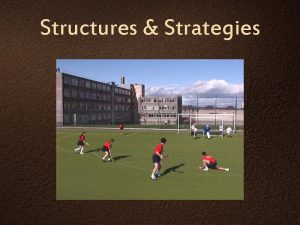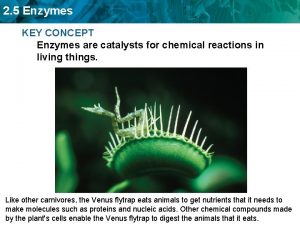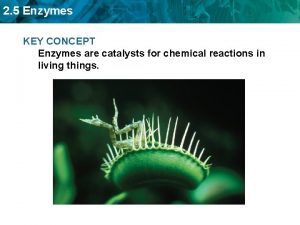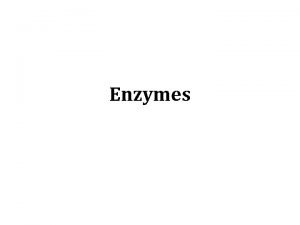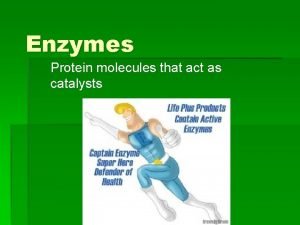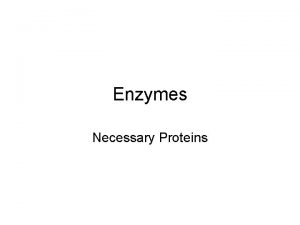2 5 Enzymes KEY CONCEPT Enzymes are catalysts










- Slides: 10

2. 5 Enzymes KEY CONCEPT Enzymes are catalysts for chemical reactions in living things.

2. 5 Enzymes A catalyst lowers activation energy. • Catalysts are substances that speed up chemical reactions. – decrease activation energy – increase reaction rate

2. 5 Enzymes allow chemical reactions to occur under tightly controlled conditions. • Enzymes are catalysts in living things. – Enzymes are needed for almost all processes. – Most enzymes are proteins.

2. 5 Enzymes • Disruptions in homeostasis can prevent enzymes from functioning. – Enzymes function best in a small range of conditions. – Changes in temperature and p. H can break hydrogen bonds. – An enzyme’s function depends on its structure.

2. 5 Enzymes • An enzyme’s structure allows only certain reactants to bind to the enzyme. – substrates – active site substrates (reactants) enzyme Substrates bind to an enzyme at certain places called active sites.

2. 5 Enzymes • The lock-and-key model helps illustrate how enzymes function. – substrates brought together – bonds in substrates weakened Substrates bind to an enzyme at certain places called active sites. The enzyme brings substrates together and weakens their bonds. The catalyzed reaction forms a product that is released from the enzyme.

2. 5 Enzymes • Factors that Affect Enzyme Activity üTemperature has a major impact on reaction rate. üAs temperature increases, collisions between substrates and active sites occur more frequently as molecules move faster. üHowever, at some point the bonds begin to weaken and the protein denatures. üEach enzyme has an optimal temperature.

2. 5 Enzymes ü p. H also influences shape and therefore reaction rate, each enzyme has an optimal p. H too. ü This falls between p. H 6 - 8 for most enzymes. ü However, digestive enzymes in the stomach are designed to work best at p. H 2 while those in the intestine are optimal at p. H 8, both matching their working environments. ü Raising or lowering the p. H will denature the protein.

2. 5 Enzymes • Denaturation üA process in which a protein unravels and loses its native conformation, thereby becoming biologically inactive.

2. 5 Enzymes • Exercises üDescribe how the interaction between an enzyme and its substrates changes a chemical reaction üHow does a catalyst affect the activation energy of a chemical reaction? üSome organisms live in very hot or very acidic environments. Would their enzymes function in a person’s cells? Why or why not? üSuppose the amino acids that make up an enzyme’s active site are changed. How might this change affect the enzyme? üOrganisms need to maintain homeostasis. Why is homeostasis important for the function of enzymes?
 Mikael ferm
Mikael ferm Relational escalation catalysts
Relational escalation catalysts Chapter 4 lesson 4: metamorphic rocks answer key
Chapter 4 lesson 4: metamorphic rocks answer key Lesson 1 waves answer key
Lesson 1 waves answer key Revenue streams example business model canvas
Revenue streams example business model canvas Key partners
Key partners True self ideal self
True self ideal self Perbedaan pemasaran dan penjualan
Perbedaan pemasaran dan penjualan Concept statement examples
Concept statement examples Igneous rocks concept map
Igneous rocks concept map Concept covered energy flow answer key
Concept covered energy flow answer key








